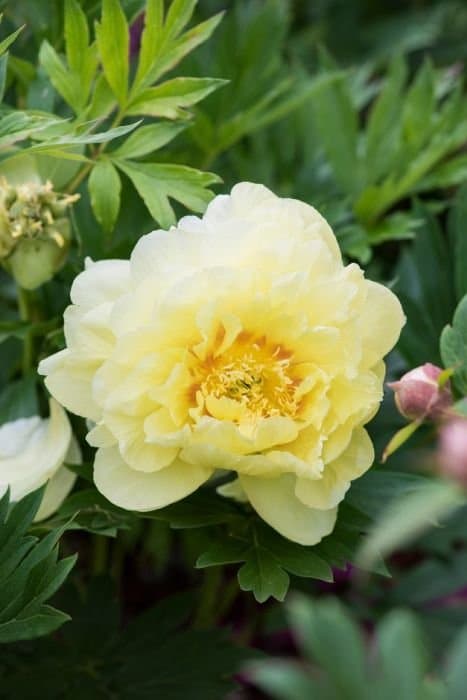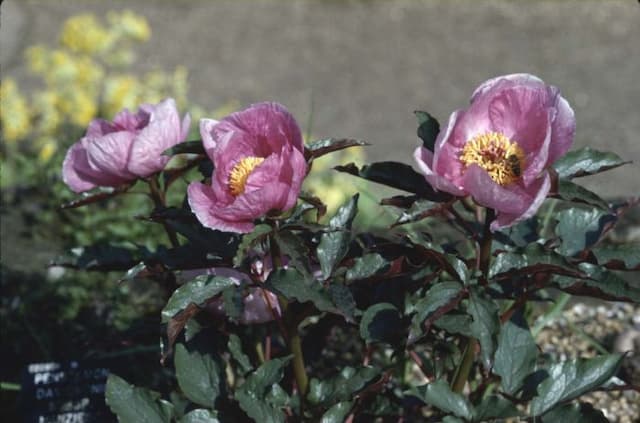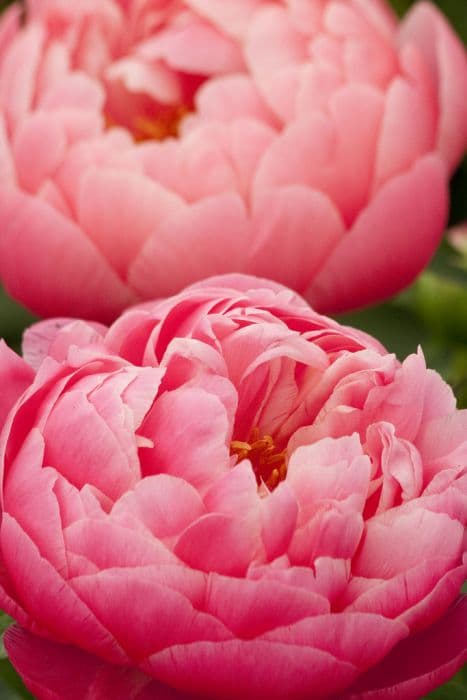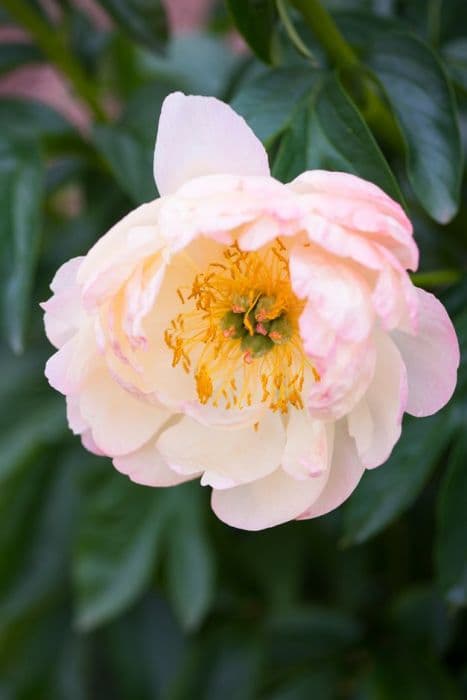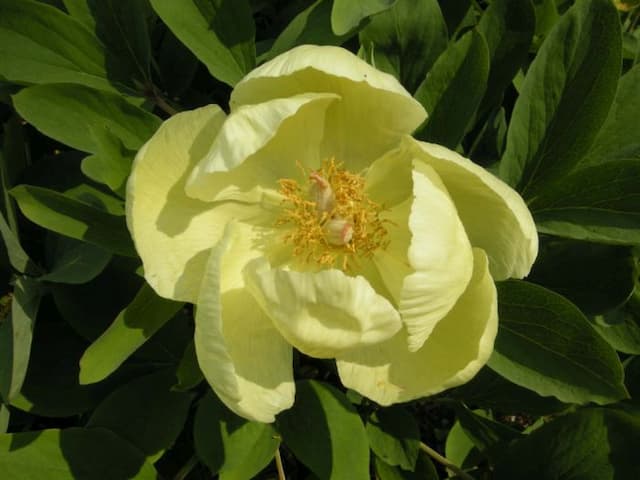Peony Paeonia lactiflora 'Mr G.f. Hemerik'

ABOUT
'Mr. G.F. Hemerik' is a popular variety of peony, characterized by its lavish, showy flowers and striking appearance. The peony blooms exhibit a deep pink hue, sometimes considered to border on a rich magenta. Each flower consists of a large number of petals, which are densely arranged creating a lavish, full-bodied look. At the center of the blooms, the petals tend to be more ruffled, adding to their decorative, luxurious feel. The leaves of 'Mr. G.F. Hemerik' peony are a deep green, providing a lush backdrop for the blossoms. The foliage typically exhibits a glossy surface with a leathery texture, arranged alternately along the stems. The leaves are divided into leaflets, which themselves may have a slightly rounded or pointed appearance, contributing to the plant's overall ornamental quality. In terms of its overall form, the plant presents a bushy habit, with stems that emerge straight and support the weight of the large flowers. These stems branch out from the base, creating a full and rounded shape that adds to the visual impact of the plant when in full bloom.
About this plant
 Names
NamesFamily
Paeoniaceae
Synonyms
Chinese Peony, Common Garden Peony
Common names
Paeonia lactiflora 'Mr G.f. Hemerik'.
 Toxicity
ToxicityTo humans
The Peony is generally considered non-toxic to humans. Ingesting parts of this plant is not commonly associated with serious poisoning. However, it is possible that some individuals may experience mild gastrointestinal upset if they consume parts of the plant, such as nausea or diarrhea, but significant toxicity is rare.
To pets
Peonies are considered to be potentially toxic to pets, particularly to dogs and cats, although severe poisoning is unusual. If a pet ingests part of a Peony, they may experience symptoms such as vomiting, diarrhea, or drooling. In most cases, these symptoms will be relatively mild, but it's always best to consult with a veterinarian if you suspect that your pet has ingested any part of this plant.
 Characteristics
CharacteristicsLife cycle
Perennials
Foliage type
Deciduous
Color of leaves
Green
Flower color
Pink
Height
2-3 feet (0.6-0.9 meters)
Spread
2-3 feet (0.6-0.9 meters)
Plant type
Herbaceous
Hardiness zones
3-8
Native area
Asia
Benefits
 General Benefits
General Benefits- Attracts Pollinators: Paeonia lactiflora 'Mr G.f. Hemerik', commonly known as Chinese Peony, attracts bees and butterflies, thereby supporting the local ecosystem.
- Ornamental Value: The plant has large, showy flowers that add aesthetic appeal to gardens and landscapes.
- Perennial Growth: As a perennial, it returns each year, reducing the need for replanting and providing long-term garden interest.
- Seasonal Interest: Chinese Peonies have a distinct blooming season in spring, creating a seasonal highlight in the garden.
- Cut Flowers: The blooms make excellent cut flowers for arrangements and can bring the beauty of the garden indoors.
- Drought Tolerance: Once established, these peonies are relatively drought tolerant, requiring less watering.
- Cold Hardy: They can survive in cold climates, making them suitable for a wide range of geographic locations.
- Diverse Landscaping Options: The plant can be used in borders, as specimen plants, or for mass planting, offering versatility in garden design.
- Low Maintenance: Chinese Peonies require minimal care once established, making them a good choice for both novice and experienced gardeners.
- Resistant to Deer: The plant is generally resistant to deer, which can help maintain its beauty in areas where deer are a problem.
- Long Lifespan: Peonies can live for decades, providing long-lasting enjoyment without the need to replace them frequently.
 Medical Properties
Medical PropertiesThis plant is not used for medical purposes.
 Air-purifying Qualities
Air-purifying QualitiesThis plant is not specifically known for air purifying qualities.
 Other Uses
Other Uses- Peony petals can be used to add a delicate flavor to summer salads or desserts when they are free of pesticides and chemicals.
- The blooms can be used to create natural dyes for fabric or paper, yielding soft hues of pink and cream.
- Dried peony petals can serve as a fragrant addition to homemade potpourri, promoting a gentle, floral scent in the home.
- As an artistic muse, peonies can inspire painters, photographers, and other artists with their form and beauty.
- Peony flowers can be candied and used as elegant decorations for cakes and pastries.
- Petal-infused water can serve as a mild facial toner or rinse for those who prefer gentle, natural skincare.
- Peony petals can be incorporated into homemade soaps and bath bombs for a touch of natural fragrance and color.
- The flowers can be used in the practice of flower reading, a type of divination or meditation, to inspire personal insight and contemplation.
- Peonies can be pressed and included in personalized stationery or bookmarks for a unique botanical touch.
- Whole peony blossoms can float in large bowls as part of a decorative, aromatic centerpiece for events or simply to beautify a space.
Interesting Facts
 Feng Shui
Feng ShuiPeonies are used in Feng Shui to attract romance and prosperity. Place peonies in the southwest corner of a garden or room to enhance love and marriage prospects, or in the southeast to encourage wealth and abundance.
 Zodiac Sign Compitability
Zodiac Sign CompitabilityThe peony is not used in astrology practice.
 Plant Symbolism
Plant Symbolism- Prosperity: The peony, to which Paeonia lactiflora 'Mr G.F. Hemerik' belongs, is often associated with wealth and honor. In many cultures, they symbolize a wish for economic fortitude and success.
- Beauty: With its large, full blooms, the peony is considered a symbol of beauty, often representing the idealized form of beauty in many literary and artistic works.
- Romance: Peonies are frequently used in weddings and romantic bouquets, symbolizing a happy marriage, compassion, and the blissful bloom of love.
- Happiness and Good Fortune: The peony is a popular symbol for good luck and high spirits, making it a common gift for celebratory occasions as it is believed to bring about positive energy.
- Nobility: In ancient times, peonies were often associated with royalty and the nobility. They are believed to represent nobleness and the value of honor.
 Water
WaterPeonies like 'Mr G.F. Hemerik' require consistent moisture, but it's important to avoid overwatering. Water the peony once a week with about 1 inch of water, taking care not to wet the foliage as this can increase the risk of fungal diseases. During hot and dry periods, increase watering to twice a week. If the plant is established, it requires less frequent watering, but ensure the soil doesn't become completely dry. It's best to provide deep, infrequent watering to encourage deep root growth rather than light, frequent watering.
 Light
LightPeonies such as 'Mr G.F. Hemerik' thrive best in full sun to partial shade. A minimum of six hours of direct sunlight each day is ideal for flower development. Planting in a spot that receives morning sunlight and afternoon shade can help protect the blooms from intense midday heat, ensuring your peony remains healthy and vibrant.
 Temperature
TemperaturePeonies like 'Mr G.F. Hemerik' prefer a temperate climate with winters that provide chilling for dormancy. They can tolerate a winter low down to about -20°F and a summer high up to 80°F. The ideal growing temperature for peonies is between 65°F and 75°F during their growing season.
 Pruning
PruningPeonies such as 'Mr G.F. Hemerik' should be deadheaded after flowering by removing spent blooms to promote plant health and prevent seed development which can sap energy from the plant. In the fall, after the first frost, cut back the foliage to ground level to prevent overwintering diseases. Pruning is typically not required during the growing season unless there is dead or damaged tissue.
 Cleaning
CleaningAs needed
 Soil
SoilThe best soil mix for the garden peony (Paeonia lactiflora 'Mr G.F. Hemerik') should be well-draining with a rich, loamy composition, supplemented with organic matter like compost. The soil pH should be neutral to slightly alkaline, around 6.5 to 7.5.
 Repotting
RepottingGarden peonies like Paeonia lactiflora 'Mr G.F. Hemerik' are perennial plants that do not need frequent repotting; they should be replanted every 10-15 years or when they become overcrowded.
 Humidity & Misting
Humidity & MistingGarden peonies (Paeonia lactiflora 'Mr G.F. Hemerik') prefer outdoor conditions and are quite hardy; they do not require specific humidity levels and can tolerate the climate's natural humidity variations.
 Suitable locations
Suitable locationsIndoor
Not ideal for indoors; requires cold dormancy.
Outdoor
Plant in full sun, enrich soil, ensure drainage, space well.
Hardiness zone
3-8 USDA.
 Life cycle
Life cyclePaeonia lactiflora 'Mr. G.F. Hemerik', commonly known as the Chinese peony, starts its life cycle as a dormant tuberous root in the winter. In early spring, red shoots emerge from the soil, developing into large, green, divided leaves. By late spring or early summer, the plant produces large, showy flowers that can be single, semi-double, or double, displaying an array of colors depending on the cultivar. After pollination, typically by insects, the flowers may develop into seed pods if not deadheaded, releasing seeds in late summer. The foliage remains through the summer and begins to wither as autumn approaches. The plant re-enters dormancy after the first frost, retreating back into the ground until the next growing season begins, completing its annual cycle.
 Propogation
PropogationPropogation time
Early Spring
Propogation: Paeonia lactiflora 'Mr G.f. Hemerik', commonly known as the Chinese peony, is typically propagated via division, which is best done in the fall after the plant has gone dormant. This involves carefully digging up a mature plant and gently separating the root ball into smaller sections, each with at least 3-5 eyes, or growth buds. These sections should be replanted in well-prepared soil at a depth where the eyes are approximately 1-2 inches below the surface, which is around 2.5 to 5 centimeters. This method allows for the creation of new, genetically identical plants that will mature and flower in a few years. Proper care during the first few years including winter mulching, especially in colder climates, will help ensure healthy growth and beautiful blooms.
